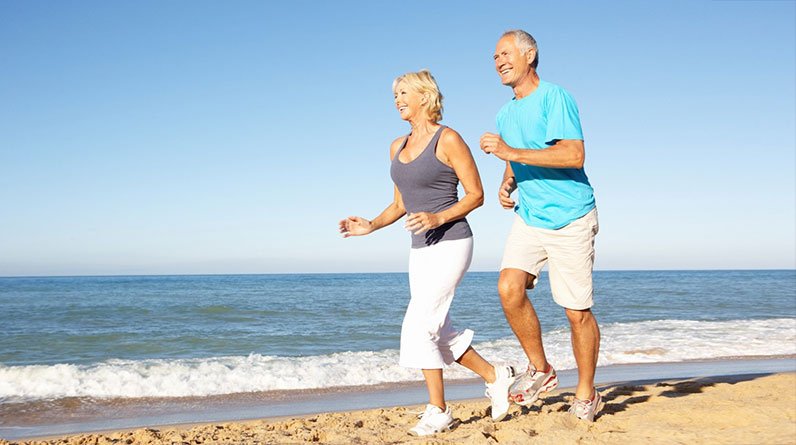
Physical Fitness for Seniors
The physiology of aging is a complex and multifaceted process that is influenced by a variety of factors. By understanding the underlying mechanisms of aging, steps can be taken to maintain good physical health and longevity as we get older.
One key step toward improving physical and mental health and increasing longevity as we age is physical fitness and exercise.
In what follows, we’ll be discussing the many factors involved in senior exercise and physical fitness. We’ll also explore the many changes that occur as a result of the natural aging process and how these changes impact senior abilities. Finally, we’ll explore several exercise examples that are accessible and effective for most seniors.
The Physiology of Aging
Aging is a complex process that is influenced by a variety of factors, including genetics, lifestyle, and environmental factors. For example, certain genetic variations may make an individual more prone to certain age-related conditions.
One of the key biological processes that occur during aging is the gradual decline in cellular function. As we age, our cells become less efficient at repairing themselves and carrying out their normal functions, which can lead to a decline in overall organ function. This decline in cellular function is thought to be caused by a number of factors, including oxidative stress, inflammation, and the accumulation of damaged DNA and proteins.
Another aspect of the physiology of aging is the loss of muscle mass and strength, which is known as sarcopenia. This decline in muscle mass and strength is thought to be caused by hormonal changes, reduced physical activity, and a decline in the production of proteins that help preserve muscle function.
Physical Activity and Aging
Physical activity and exercise are important at any age, but they become increasingly important as we get older.
Regular physical activity has numerous benefits for aging bodies, including the maintenance of muscle mass and strength, the improvement of cardiovascular health, and the prevention of chronic diseases such as obesity, diabetes, and heart disease.
Preservation Of Muscle Mass And Strength
One of the key benefits of exercise for older adults is the preservation of muscle mass and strength. This decline in muscle mass can lead to impaired mobility and an increased risk of falls and injuries.
Regular exercise and strength training can help preserve muscle mass and utility, improving balance and stability and reducing the risk of falls and injuries.
Improvement of Cardiovascular Health
Regular exercise can also improve cardiovascular health and enhance longevity. In addition, physical activity helps lower blood pressure, improve cholesterol levels, and reduce the risk of heart disease and stroke risk.
Management of Chronic Conditions
Exercise can also help improve or prevent chronic health issues such as obesity, diabetes, and heart disease. Exercising regularly does remarkable things for body homeostasis and can truly improve these medical issues.
Maximizing Mental Health
Finally, it is also important to consider the mental health benefits of physical activity, particularly for seniors. Regular physical activity has been shown to improve mood, reduce feelings of anxiety and depression, and improve cognitive function.
One of the ways that exercise may improve mental health is by increasing the production of certain chemicals in the brain, such as endorphins and serotonin. These chemicals are known as “feel-good” chemicals because of their helpful effects.
Exercise can also stimulate the production of brain-derived neurotrophic factor, a protein that helps to support the growth and survival of neurons in the brain. This protein can help to improve cognitive function and may even help to delay the onset of age-related cognitive decline.
In addition to the direct effects on the brain, exercise can also have indirect effects on mental health by promoting a sense of accomplishment and social connection. Participating in physical activity, particularly in a group setting, can provide a sense of accomplishment and community, which can positively impact mental health.
Exercises for Seniors
As we age, it is important to maintain a regular exercise routine to maintain and improve overall senior health. While physical challenges or disabilities may limit some seniors, there are still many accessible and effective exercises that can be incorporated into an exercise routine.
- Walking
Walking is an easy and convenient exercise that can be done almost anywhere, and it has numerous benefits for seniors. It is low impact, which means it is easy on the joints, and it can help to improve cardiovascular health, maintain muscle mass and strength, and improve balance and stability.
- Swimming
Swimming is another low-impact exercise that can be a great option for seniors. It is a great cardiovascular workout, and it can help to improve flexibility and range of motion. Swimming is also a great option for those who are overweight or have joint problems.
Strength training
Strength training is an important part of any exercise routine, as it helps to preserve muscle mass and strength. Strength training can be done using weights, resistance bands, or even bodyweight exercises. It’s imperative to start gradually and increase the intensity as strength and endurance improve.
- Yoga
Yoga is a great option for seniors as it can help to improve flexibility, balance, and strength. It is also a great way to reduce stress and improve overall well-being. Many yoga studios offer classes specifically designed for seniors, which can be a great way to get started.
- Tai Chi
Tai chi is a low-impact exercise that involves slow, controlled movements and deep breathing. It can help to improve balance, coordination, and flexibility, and it has been shown to reduce the risk of falls and injuries. Tai chi can be performed standing or seated, making it a great option for those with physical challenges or disabilities.
Final Thoughts
For seniors who want to improve their overall well-being, physical fitness is an excellent activity. Often, senior living facilities have this activity as part of a daily routine.
Public classes are also an option for many seniors, and the multitudes of classes available provide excellent variety for senior needs.
